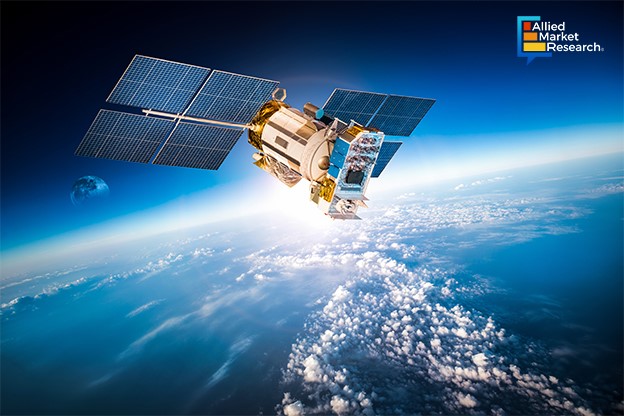Which Advanced Satellite Technologies have Transformed the Outlook of the Sector?

10 Apr
2024
Highlights
- Introduction
- Advanced technologies in the satellite industry
- Notable satellite launches
The satellite industry is a vibrant and complex sector focused on the launch, production, utilization, and management of artificial satellites. These satellites are placed into different orbits around Earth or other celestial bodies for a wide range of objectives, such as communication, Earth monitoring, navigation, scientific investigations, and space exploration, The global satellite industry is anticipated to manifest the fastest CAGR of 8.1% by 2032. The industry has experienced growth due to surge in the use of small satellites, increase in demand for satellite-based warfare, and rise in the number of space exploration missions.
Advanced technologies in the satellite industry
Spacecraft propulsion
Advanced power and propulsion systems with high capacity are essential for satellites to venture into deep space and execute complex tasks. As a result, innovative solutions such as high-power solar arrays and advanced battery technologies are integrated into newly developed satellites. Startups have redesigned lightweight thrusters to enhance performance and are similarly refining chemical propulsion systems for thrusters.
In addition, there is a trend toward integration of sustainable propulsion systems into satellite designs. Among these environmentally friendly propulsion technologies, startups and scaleups have mostly adopted electric propulsion over conventional systems. Alternative solutions include electromagnetic tethering, and nuclear, solar, water, laser, & iodine-based propulsion.
IoT in Satellite
The demand for satellite enabled IoT is steadily increasing due to the broad coverage provided by satellites in comparison to current terrestrial infrastructure. Both governmental and private sector investments in satellite technology for connected solutions have propelled technological advancements in satellite IoT. Commercial applications utilize IoT sensors and devices for real-time and precise monitoring, remote surveillance, and asset tracking, on a global scale.
Recent developments in satellite communication have opened opportunities for cloud and edge computing capabilities. Among the notable advancements in satellite IoT, significant progress has been observed in its utilization within military and defense applications.
Integration of AI
The substantial volume of data gathered by satellites presents challenges in data processing, analysis, and efficient resource allocation. Machine learning and AI play crucial roles in analyzing satellite data acquired from GNSS (global navigation satellite systems), remote sensing, and EO (earth observation). AI-based data analysis in cloud environments has facilitated the emergence of GSaaS (Ground-Station-as-a-Service) solutions. Moreover, ground stations use AI for ground based SSA (Space Situational Awareness) to direct satellites for course corrections and optimize resource utilization. In space operations, AI is utilized for satellite tracking and real-time orbit prediction, enabling enhanced space traffic management.
How do frontrunners lead their supremacy in the dynamic industry?
The satellite industry is competitive, and top entities discover new products by investing in R&D activities. Furthermore, prominent satellite corporations are expected to invest in the development of advanced satellite technologies, aiming to augment the capabilities of satellite services across the globe. This initiative is poised to accelerate the expansion of the satellite sector. Government and private entities have adopted strategies such as acquisitions, collaborations, mergers, and partnerships to sustain the dynamic industry. For instance, in April 2024, SpaceX sent out another group of its Starlink internet satellites. From Vandenberg Space Force Base in California, a Falcon 9 rocket launched, carrying 22 Starlink spacecraft. The launch had been postponed twice due to unfavorable weather conditions.
On the other hand, in January 2024, Japan initiated a mission by launching a rocket from the Tanegashima Space Center in southwestern Japan. This rocket, operated by Mitsubishi Heavy Industries Limited, was tasked with the deployment of a government intelligence-gathering satellite. The primary objectives of this mission were to monitor activities at military installations in North Korea and enhance Japan's capacity to respond to natural disasters. The optical satellite carried aboard the H2A rocket was a crucial component of Tokyo's strategy to strengthen its military abilities.
To conclude, the global satellite industry has experienced growth due to surge in use of small satellites, increase in demand for satellite-based warfare, and rise in number of space exploration missions. However, advanced applications of satellites and an increase in demand for space data are expected to open new avenues for the industry in the upcoming era.
For detailed information on the investment opportunities and competitive scenario of the global satellite sector, feel free to contact us!

Koyel Ghosh
Author’s Bio- Koyel Ghosh is a blogger with a strong passion and enjoys writing in miscellaneous domains, as she believes it lets her explore a wide variety of niches. She has an innate interest in creativity and enjoys experimenting with different writing styles. A writer who never stops imagining, she has been serving the corporate industry for the last five years.
Innovative Spacecraft Technologies that Are Opening New Growth Opportunities for Space Exploration Businesses
Avenue: Entire Library membership of Allied Market Research Reports at your disposal
- Avenue is an innovative subscription-based online report database.
- Avail an online access to the entire library of syndicated reports on more than 2,000 niche industries and company profiles on more than 12,000 firms across 11 domains.
- A cost-effective model tailored for entrepreneurs, investors, and students & researchers at universities.
- Request customizations, suggest new reports, and avail analyst support as per your requirements.
- Get an access to the library of reports at any time from any device and anywhere.
Related Post
-
How are Submarine Cables Transforming Global Connectivity with Enhanced User Experience?
-
Endoscopy Procedures: Transformations in Techniques and Applications
-
AI-Powered Video Analytics: How the Product Actually Works for enterprises
-
Painting Robots: Transforming Precision Coating and Creative Applications
-
Innovations in Pharmacovigilance Systems Advancing Patient Safety
-
Understanding Edge Security: Keeping Data Safe Near the Source
-
Exploring the Use and Advancements of 3D Laser Scanners in Professional Applications
-
Reinforcing Industrial Controls with Smarter Tools and Training








